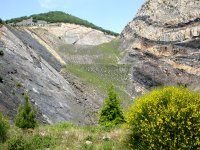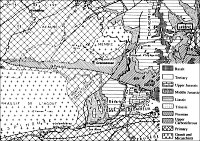The Stephanian flora of Graissessac (Fr)
Click on the photos for enlargement and more information.
Graissessac is a former miners' village in the Languedoc (south of France),
not far from Bédarieux. In the course of years many fossils from the
Upper Carboniferous have been found there, but the mining was stopped years
ago. At the waste heaps some fossils can still be collected.

 The coal excavation in Graissessac was done in opencast
coal pits. This means that first the overlaying layers were removed. This
material was deposited on slopes at other places. Then the coal was
extracted. The coal excavation in Graissessac was done in opencast
coal pits. This means that first the overlaying layers were removed. This
material was deposited on slopes at other places. Then the coal was
extracted.
When we went collecting there for the first time, we could simply look on
the slopes along the roads. Nowadays these slopes are almost completely overgrown
and it is not possible to find fossils there anymore, except perhaps with
great effort. Still there are some possibilities at places where waste heaps
are being dug away.
About the geology
The coal has come into existence in a so-called intramontane basin.
During the Westfalian (the last but one level of the Carboniferous) the Hercynian
process of mountain building (orogeny) was at its maximum. In the Stephanian
the process came to an end and as a consequence of the 'relaxation' of the
earth's crust small depressions, bordered by faults, came into existence,
e.g. around and in the Massif Central. Graissessac is situated in such a
depression. The new mountains suffered from a severe erosion and pieces of
rock, sand and mud were transported downwards by mountain streams and rivers.
 In the
valleys large swamps with abundant growth of plants came into existence.
The peat layers were converted into coal seams in the course of 300 million
of years and above these coal layers sediments with plant fossils were formed. In the
valleys large swamps with abundant growth of plants came into existence.
The peat layers were converted into coal seams in the course of 300 million
of years and above these coal layers sediments with plant fossils were formed.
There are more intramontane basins in the south of France, e.g. near Alès
(where the winning is still going on and where fossils can be found),
Decazeville, Carmaux and Montceau-les-Mines. The latter sites have only poor
possibilities nowadays.
In Graissessac the coal has already been extracted since the 18th century
and in 1918 the productivity reached its top. Around the year 2000 the last
quarry was shut down.
The flora
 The
depositions of Graissessac certainly can said to be rich in fossils. Especially
the group of Pecopteris, real ferns, is dominant in the flora, as
can be seen in the histogram on the right. Many of the fernlike fossils originate
from seed ferns, gymnosperm plants. But in Graissessac (and in the Stephanian
in general) the real ferns form an important part of the flora. The
depositions of Graissessac certainly can said to be rich in fossils. Especially
the group of Pecopteris, real ferns, is dominant in the flora, as
can be seen in the histogram on the right. Many of the fernlike fossils originate
from seed ferns, gymnosperm plants. But in Graissessac (and in the Stephanian
in general) the real ferns form an important part of the flora.
The total number of species we have found is about 40 and this is an average
result compared with other finding places. Many species of these 40 however
are rather rare and some of them we have found only once.
Because of the fact that my wife and I have only collected in a small
number of sites, the overview given below will probably not be representative
for the entire basin.
Animal remains do occur, but they are very rare.
Click on the photos below to proceed.
Conclusion
The overview is certainly not complete. Our collection contains
still many pieces that could be something different, but that are too unclear
to identify.
Still it is possible to get a good impression of a number of important
plants of the Stephanian: Pecopteris, Odontopteris,
Dicksonites, Pecopteridium, Sigillaria brardii and
Sphenophyllum oblongifolium, to mention some of them. The club moss
trees are strongly declining, the tree fern Psaronius with its
Pecopteris-leaves is in a flowering time, the seed ferns
Neuropteris and Alethopteris are getting less numerous, but
they are replaced by other seed ferns like Odontopteris.
Nice place for fossils, this Graissessac! A pity that the coal winning
has been shut down. But if the oil prices will rise enough, the mining will
become attractive again!
References
Top |